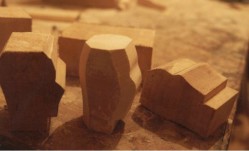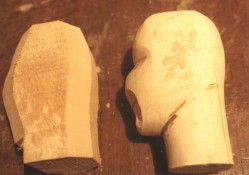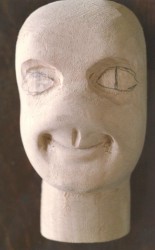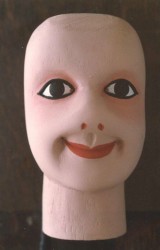Manufacture
When Mourguet created his first puppets he used the wood of the lime tree.
The lime wood is easy to sculpt and is also very light which makes it easier to manipulate as, let's not forget, the puppet is held at the end of the arm !
From one piece of wood, many puppet heads can be made.
Preparing the wood
Once the tree as been felled, it is sawn into planks before being cut into blocks.
As the wood is very light, this work creates a lot of sawdust which can make the labour particularly unpleasant.
Only the finest branches are used. We talk of puppets being created from « the heart » of the tree as the sculptor only selects the purest wood. The face is always carved from the North-facing wood, as it is softer and easier to shape. The neck and back of the head are always sculpted from the South-facing wood which tends to be harder and thus more durable (in traditional puppet shows, the puppets often hit one another). E.g. Punch and Judy.
|
|
|
The planks are cut into blocks depending on the size of the puppet to be made. Often for larger puppets, two blocks must be stuck together.
Taking shape
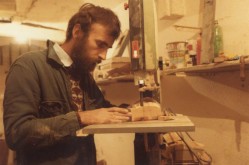 Once the block has been cut, the sculptor draws the profile of the puppet. Each one is taken from photographs of Neichthauser's puppets. The profile is then carefully cut with a saw.
Once the block has been cut, the sculptor draws the profile of the puppet. Each one is taken from photographs of Neichthauser's puppets. The profile is then carefully cut with a saw.
Using a lathe, the head is then turned and finely shaped. It is a highly skilled task, and takes many years to perfect. If not, a gouge is used.
From now, on everything is sculpted by hand.
|
|
|
The smallest details are made using different sized gouges and finally the head is finely sanded to eliminate any rough edges.
At the end of the sculpture
Once the head is finished it has to become a puppet. A hole is drilled underneath the neck, just large enough to place an index finger. It must be carefully centered otherwise the puppet head will not be balanced and will be difficult to manoeuvre.
This whole phase will take two days, regardless of the size of puppet.
|
|
|
Now the head is ready for painting. Before this can be done, the wood is treated to prevent the paint soaking in.
Once painted, the puppet will be given hair and clothing.
This process will take a further two days making four days in total to create a puppet from start to finish.
Ready for the show
The puppet is now ready to perform and express himself in the puppet theatre : « le castelet ».
|
|
With kind permission of l'Ateyer de Guignol (Gilbert and Geneviève Pavaly).



